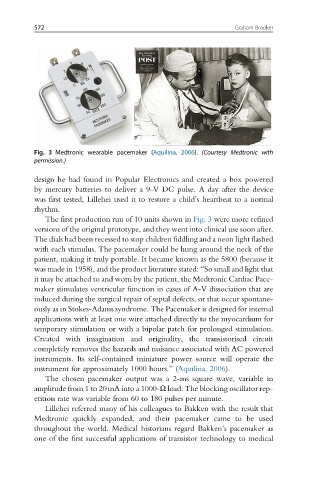Page 579 - Handbook of Biomechatronics
P. 579
572 Graham Brooker
Fig. 3 Medtronic wearable pacemaker (Aquilina, 2006). (Courtesy Medtronic with
permission.)
design he had found in Popular Electronics and created a box powered
by mercury batteries to deliver a 9-V DC pulse. A day after the device
was first tested, Lillehei used it to restore a child’s heartbeat to a normal
rhythm.
The first production run of 10 units shown in Fig. 3 were more refined
versions of the original prototype, and they went into clinical use soon after.
The dials had been recessed to stop children fiddling and a neon light flashed
with each stimulus. The pacemaker could be hung around the neck of the
patient, making it truly portable. It became known as the 5800 (because it
was made in 1958), and the product literature stated: “So small and light that
it may be attached to and worn by the patient, the Medtronic Cardiac Pace-
maker stimulates ventricular function in cases of A-V dissociation that are
induced during the surgical repair of septal defects, or that occur spontane-
ously as in Stokes-Adams syndrome. The Pacemaker is designed for internal
applications with at least one wire attached directly to the myocardium for
temporary stimulation or with a bipolar patch for prolonged stimulation.
Created with imagination and originality, the transistorised circuit
completely removes the hazards and nuisance associated with AC powered
instruments. Its self-contained miniature power source will operate the
instrument for approximately 1000 hours.” (Aquilina, 2006).
The chosen pacemaker output was a 2-ms square wave, variable in
amplitude from 1 to 20mA into a 1000-Ω load. The blocking oscillator rep-
etition rate was variable from 60 to 180 pulses per minute.
Lillehei referred many of his colleagues to Bakken with the result that
Medtronic quickly expanded, and their pacemaker came to be used
throughout the world. Medical historians regard Bakken’s pacemaker as
one of the first successful applications of transistor technology to medical

